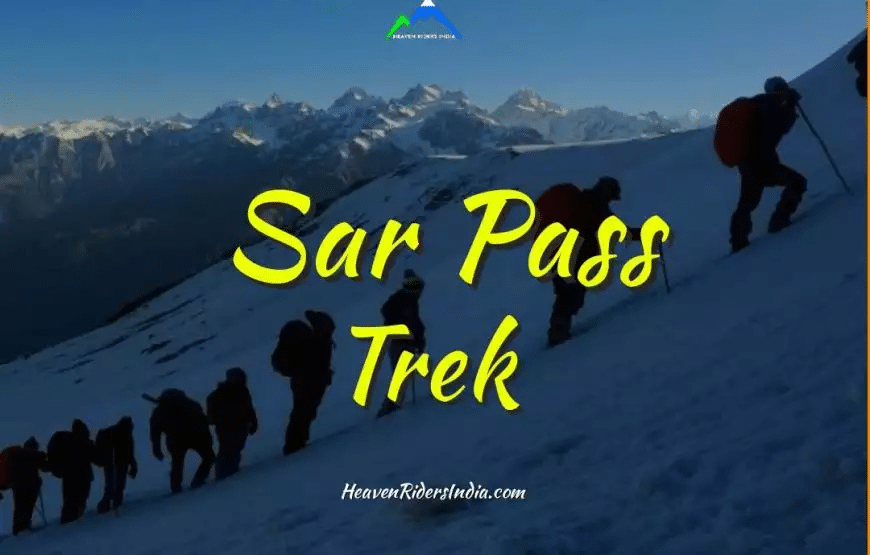If you’re an admirer of mountains, adventure, and panoramic views, then the Sar Pass Trek has to be included in your bucket list. This trek is in the Parvati Valley of Himachal Pradesh and is a perfect blend of nature, snowy terrain, and adventure. “Sar” is derived from a frozen lake, and the trekkers have to cross it along the way.
This blog will take you through all that you need to know about the Sar Pass Trek – from the time to visit, the trail, the must-haves to carry along, and why you should consider making it your next trekking escapade.
Why Choose Sar Pass Trek?
The Sar Pass Trek is best for both newbie trekkers and seasoned trekker enthusiasts alike. It begins at the lovely village of Kasol, already popular for its landscape beauty and tranquil atmosphere. You will observe new landscapes daily while trekking along pine and rhododendron forests, meadows, and snowy routes.
The highlight of the trek is, naturally, the crossing of Sar Pass, which is snow-covered nearly throughout the year. The sight from the top is simply breathtaking – a panoramic view of snow-clad peaks, valleys, and pine-covered hills.
Route and Itinerary of Sar Pass Trek
Here’s a standard 5 to 6-day itinerary of the Sar Pass Trek:
Day 1: Arrival at Kasol
Reach Kasol, a small town located on the Parvati River banks. It is the trek base camp. Relax at local cafes and prepare for your trek for the day.
Day 2: Kasol to Grahan (approx. 9 km)
The hike starts with a serene walk along the Parvati River. Cross the river and the trail takes you through thick forests to Grahan village. It’s a serene hamlet where you will be able to bask in the hospitality of Himachali people.
Day 3: Grahan to Min Thach (approx. 7 km)
This part of the trek is a bit steeper but offers beautiful views. You’ll pass through pine forests and open meadows. Min Thach is a grassy campsite surrounded by tall trees and snow-capped peaks.
Day 4: Min Thach to Nagaru (approx. 8 km)
This is the most difficult section as you achieve considerable altitude. The weather turns cold, and the path may have snow according to the season. The Nagaru campsite provides a spectacular night under a star-filled sky.
Day 5: Nagaru to Biskeri Thach via Sar Pass (approx. 14 km)
The day of days! You will traverse the actual Sar Pass Trek trail. The ascent is steep, and you will trek over snow for most of the day. Once at the pass, you can slide down the snow slopes – an exhilarating experience in the trek. Then you arrive at the green meadows of Biskeri Thach.
Day 6: Biskeri Thach to Barshaini and return to Kasol
The final section of the trek involves going through forests, streams, and villages such as Pulga and Tulga. From Barshaini, you will travel in a vehicle back to Kasol.
Best Time to Go for Sar Pass Trek
Sar Pass Trek should be undertaken from May to June or September to October. It is during these periods that the weather is calm, the snow still exists on the pass, and the views are most unobstructed. Monsoons are not advisable because the trails are slippery and landslides occur.
What to Pack for Sar Pass Trek
It is essential to be well-equipped in order to enjoy your trek safely. Below is a list of things to bring:
- Waterproof trekking shoes
- Woolen attire and thermals
- Windproof and waterproof jacket
- Gloves, woolen cap, and sunglasses
- Personal medicines and first-aid kit
- Sunscreen and lip balm
- Trekking pole (optional but useful)
- Power bank and torch
Physical Preparation
Although the Sar Pass Trek is beginner-friendly, it still demands a reasonable amount of physical fitness. You must begin exercising at least 3-4 weeks prior to the trek. Jogging, walking, stair climbing, or cycling for 30–45 minutes a day can enhance your stamina.
Unique Experiences on Sar Pass Trek
- The thrill of snow trekking: Trekkings through snow trails and sliding down snow slopes is an experience you’ll never forget.
- Camping under the stars: You’ll camp at scenic spots such as Min Thach and Nagaru amidst nature.
- Local culture: Interacting with villagers in Grahan and Biskeri allows you to experience the Himachali way of life firsthand.
- Ever-changing landscapes: From forests to snow-covered passes, every day is full of new scenery and experiences.
Safety Tips for Sar Pass Trek
- Always trek with a qualified trek leader or trekking group.
- Drink plenty and eat well.
- Acclimatize properly at every level of altitude to prevent AMS (Acute Mountain Sickness).
- Don’t litter; keep the tracks clean.
- Bring your ID card and medical background if required.
Why Sar Pass Trek is Perfect for You
Whether you’re looking for your first Himalayan trek or want to relive the joy of trekking through snow, Sar Pass Trek offers the best of everything. It’s a great mix of moderate adventure, natural beauty, and peaceful camping. You’ll return with photos, memories, and stories that will last a lifetime.
The Sar Pass Trek is not merely a trek; it’s an experience to reconnect with yourself away from the distractions of everyday life. The achievement of reaching the pass and viewing the majestic Himalayan ranges is something you can’t put into words – you must feel it.
Conclusion
The Sar Pass Trek is a top favorite among treks in the Himalayas for a reason. It’s not just scenic and serene, but also the ideal mixture of challenge and fun. From traversing a snow-covered pass to camping in silent meadows, every moment is a celebration of nature’s glory.
If you’re planning your next Himalayan adventure, give the Sar Pass Trek a try – it’s an experience that will stay in your heart forever.






Comment (0)